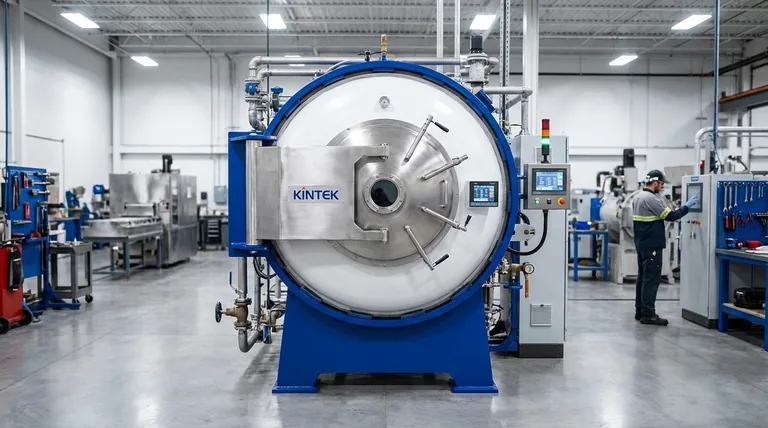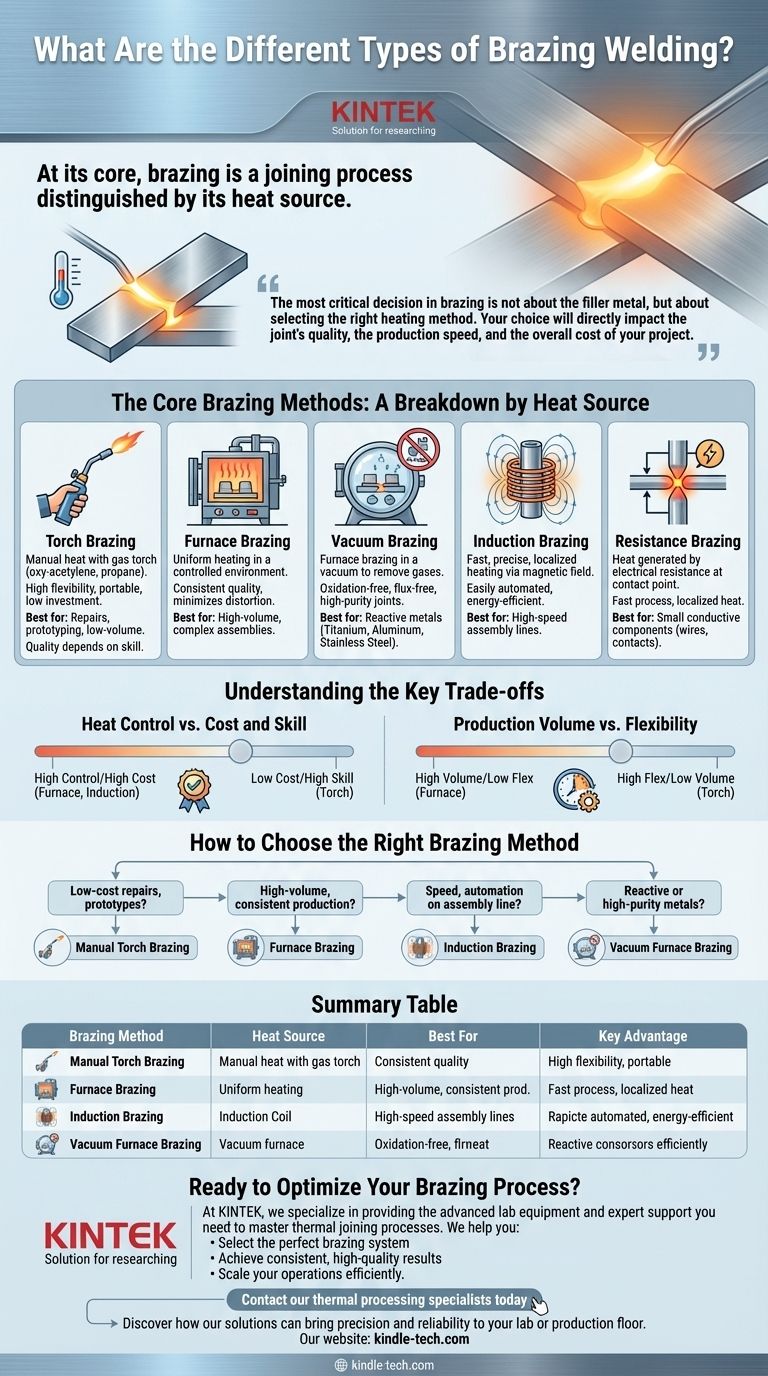본질적으로 경납접합은 열원에 의해 구별되는 접합 공정입니다. 용접과 혼동되는 경우가 많지만, 경납접합은 모재보다 낮은 온도에서 녹는 필러 금속을 사용하여 부품 자체를 녹이지 않고도 강력한 결합을 형성합니다. 경납접합의 주요 유형은 토치, 로, 유도, 저항 경납접합을 포함하여 열을 가하는 방식에 따라 정의됩니다.
경납접합에서 가장 중요한 결정은 필러 금속에 관한 것이 아니라 올바른 가열 방법을 선택하는 것입니다. 귀하의 선택은 접합부의 품질, 생산 속도 및 프로젝트의 전체 비용에 직접적인 영향을 미칩니다.
핵심 경납접합 방법: 열원별 분석
경납접합 방법은 거의 항상 열을 생성하고 적용하는 방식에 따라 분류됩니다. 각 접근 방식은 속도, 비용, 정밀도 및 다양한 재료와 생산량에 대한 적합성에 대한 고유한 프로필을 제공합니다.
토치 경납접합 (Torch Brazing)
이것은 가장 일반적이고 다재다능한 형태의 경납접합입니다. 가스 연료 토치(산소-아세틸렌 또는 프로판 등)를 사용하여 부품을 수동으로 가열하고 필러 합금을 접합부로 녹입니다.
휴대가 간편하고 초기 투자 비용이 낮아 수리, 시제품 제작 및 소량 생산에 이상적입니다. 그러나 품질은 작업자의 기술에 크게 좌우됩니다.
로 경납접합 (Furnace Brazing)
로 경납접합에서는 부품(필러 금속이 미리 배치됨)을 고온의 로에 넣습니다. 전체 어셈블리는 제어된 환경에서 경납접합 온도까지 균일하게 가열됩니다.
이 방법은 복잡한 어셈블리의 대량 생산에 완벽합니다. 왜냐하면 변형을 최소화하면서 일관되고 고품질의 접합부를 생성하기 때문입니다. 도달하기 어려운 접합부까지도 균일하게 가열되도록 보장합니다.
진공 경납접합 (Vacuum Brazing)
진공 경납접합은 로 경납접합의 특수한 유형입니다. 이 공정은 진공 상태에서 진행되며, 금속을 오염시키거나 산화시킬 수 있는 산소 및 기타 가스를 제거합니다.
이는 티타늄, 알루미늄, 스테인리스 스틸과 같은 반응성 금속을 접합하거나 깨끗하고 플럭스(flux)가 없는 접합부를 만드는 데 필수적입니다. 이는 항공우주, 의료 및 반도체 산업의 표준입니다.
유도 경납접합 (Induction Brazing)
이 방법은 유도 코일에서 생성된 교류 자기장을 사용하여 전도성 금속 부품을 가열합니다. 가열은 매우 빠르고 정밀하며 접합 영역에 국한됩니다.
유도 경납접합은 쉽게 자동화할 수 있고 반복성이 뛰어나 고속 조립 라인에 가장 적합한 선택입니다. 또한 접합이 필요한 부품 부분만 가열하므로 에너지 효율적입니다.
저항 경납접합 (Resistance Brazing)
저항 경납접합은 일반적으로 탄소 전극을 통해 전류가 흐를 때 접합부의 전기 저항을 사용하여 열을 발생시킵니다. 열은 접촉 지점에 집중됩니다.
이는 작고 전도성이 높은 부품을 접합하는 데 적합한 빠른 공정입니다. 국소 가열이 중요한 전기 접점 및 전선 부착에 일반적으로 사용됩니다.

주요 상충 관계 이해하기
경납접합 방법을 선택하는 것은 상충되는 우선순위의 균형을 맞추는 것을 포함합니다. 이러한 상충 관계를 이해하는 것은 기술적 및 비즈니스 목표에 부합하는 정보에 입각한 결정을 내리는 데 중요합니다.
열 제어 대 비용 및 기술
정밀한 열 제어는 고품질 경납접합부에 가장 중요한 요소입니다.
로 및 유도 경납접합은 탁월하고 자동화된 제어를 제공하지만 높은 초기 자본 비용이 듭니다. 토치 경납접합은 저렴하지만 열 관리에 대한 책임이 숙련된 작업자에게 전적으로 주어집니다.
생산량 대 유연성
요구되는 생산량이 선택을 결정합니다. 로 경납접합은 동일한 부품의 대량 생산을 위해 만들어졌지만, 긴 가열 및 냉각 주기 때문에 일회성 작업에는 매우 비효율적입니다.
토치 경납접합은 고유한 수리 또는 시제품에 대해 최대의 유연성을 제공하지만 대량 생산에서 자동화된 방법의 속도와 반복성을 따라잡을 수 없습니다.
재료 및 분위기 순도
접합하려는 모재는 특정 방법을 즉시 배제할 수 있습니다. 많은 고강도 합금 및 반응성 금속은 고온에서 산소에 노출되면 약화되거나 손상됩니다.
이러한 재료의 경우 토치 경납접합은 선택 사항이 아닙니다. 제어된 분위기가 필요하므로 진공 또는 불활성 가스(질소 또는 아르곤)를 사용한 로 경납접합이 유일하게 실행 가능한 선택이 됩니다.
올바른 경납접합 방법 선택 방법
특정 응용 분야와 목표가 올바른 방법을 알려줄 것입니다. 옵션을 좁히기 위해 다음 지침을 사용하십시오.
- 저렴한 수리 또는 일회성 시제품 제작이 주된 목표인 경우: 수동 토치 경납접합은 유연성과 낮은 초기 투자 비용의 최상의 조합을 제공합니다.
- 대량의 일관된 생산이 주된 목표인 경우: 로 경납접합은 대규모로 안정적인 접합부를 만드는 산업 표준입니다.
- 조립 라인에서 속도와 자동화가 주된 목표인 경우: 유도 경납접합은 비교할 수 없는 속도와 정밀하고 반복 가능한 국소 가열을 제공합니다.
- 반응성 또는 고순도 금속(예: 티타늄, 스테인리스 스틸) 접합이 주된 목표인 경우: 산화를 방지하고 접합 무결성을 보장하기 위해 진공 로 경납접합은 필수적입니다.
궁극적으로 열원 선택을 마스터하는 것이 성공적인 경납접합 작업을 위한 가장 중요한 단계입니다.
요약표:
| 경납접합 방법 | 열원 | 최적의 용도 | 주요 장점 |
|---|---|---|---|
| 토치 경납접합 | 가스 연료 토치 | 수리, 시제품 제작, 소량 생산 | 저렴한 비용, 높은 유연성 |
| 로 경납접합 | 제어된 로 | 대량 생산, 복잡한 어셈블리 | 일관된 품질, 균일한 가열 |
| 진공 경납접합 | 진공 로 | 반응성 금속(티타늄, 스테인리스 스틸) | 산화 방지, 고순도 접합 |
| 유도 경납접합 | 전자기 유도 | 자동화된 조립 라인 | 빠르고 정밀하며 국소화된 가열 |
| 저항 경납접합 | 전기 저항 | 작은 전도성 부품 | 국소 가열, 빠른 공정 |
경납접합 공정 최적화 준비가 되셨습니까?
올바른 경납접합 방법을 선택하는 것은 금속 부품에서 강력하고 안정적인 접합부를 얻는 데 중요합니다. KINTEK에서는 열 접합 공정을 마스터하는 데 필요한 고급 실험실 장비와 전문적인 지원을 제공하는 데 주력하고 있습니다.
당사는 다음을 도와드립니다:
- 특정 재료 및 생산량에 맞는 완벽한 경납접합 시스템 선택
- 정밀한 온도 제어 및 분위기 관리를 통한 일관되고 고품질의 결과 달성
- 시제품 제작부터 대량 생산까지 운영 효율적으로 확장
반응성 합금을 다루든 자동화된 솔루션이 필요하든 KINTEK은 귀하의 실험실 또는 생산 현장에 정밀도와 안정성을 더할 장비와 전문 지식을 보유하고 있습니다.
시각적 가이드




















